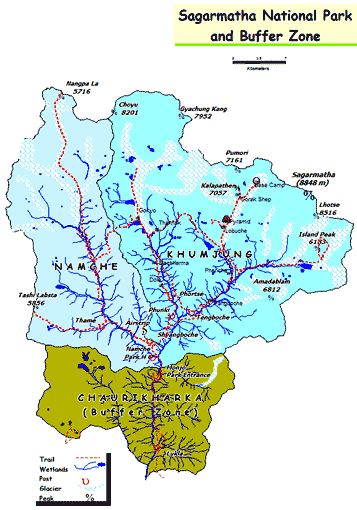 Unique
among natural heritage sites world-wide is the
Sagarmatha National Park, which includes Mt.
Everest (8,848 m) and other high peaks such
as Lhotse Shar, Cho Oyu, Ama Dablam, Pumori,
Kangtega, Gyachung Kang, Thamserku and Kwangde.
Located North-east of Kathmandu, Sagarmatha
National Park is 1,148 sq km. in area and consists
of the upper catchment areas of the Dudh Koshi,
Bhote Koshi and the Imja Khola rivers. Much
of the park lies above 3,000m. Sagarmatha is
rugged, with deep gorges, glaciers and unnegotiable
ice and rock faces. Locally known as the 'Khumbu',
it is the home of the famous Sherpa people.
The Sherpas make a living by farming barley
and potatoes and graze their yaks in high altitude
pastures. Young Sherpas have also made their
name in mountaineering and the trekking industry
has of late become the community's economic
mainstay. In 1979 the park was declared a World
Heritage Site.
Unique
among natural heritage sites world-wide is the
Sagarmatha National Park, which includes Mt.
Everest (8,848 m) and other high peaks such
as Lhotse Shar, Cho Oyu, Ama Dablam, Pumori,
Kangtega, Gyachung Kang, Thamserku and Kwangde.
Located North-east of Kathmandu, Sagarmatha
National Park is 1,148 sq km. in area and consists
of the upper catchment areas of the Dudh Koshi,
Bhote Koshi and the Imja Khola rivers. Much
of the park lies above 3,000m. Sagarmatha is
rugged, with deep gorges, glaciers and unnegotiable
ice and rock faces. Locally known as the 'Khumbu',
it is the home of the famous Sherpa people.
The Sherpas make a living by farming barley
and potatoes and graze their yaks in high altitude
pastures. Young Sherpas have also made their
name in mountaineering and the trekking industry
has of late become the community's economic
mainstay. In 1979 the park was declared a World
Heritage Site.
Trees such as rhododendron, birch,
blue pine, juniper and silver fir are found
up to an altitude of 4,000 meters above which
they give way to scrub and alpine plants. In
late spring and summer, the hillsides around
the villages of Namche Bazaar, Khumjung, Thyangboche
and Thame are a riot of colours with several
species of rhododendon in bloom. Wildlife most
likely to be seen in Sagarmatha are the Himalaya
tahr, ghoral, musk deer, pikka (mouse hare)
weasel and occasionally jackal. Other rarely
seen animals are Himalayan black bear, wolf,
lynx and snow leopard. Birds commonly seen are
Impeyan pheasant, blood pheasant, snow cock,
snow pigeon, red billed and yellow billed chough,
Himalayan griffin vulture and lammergeier.
FLORA AND FAUNA
The vegetation found at the lower altitude of
the park includes pine and hemlock forests,
while fir, juniper, birch and rhododendron,
scrub and alpine plant communities are common
at the higher altitude.
The Park is home to the red panda,
snow leopard, musk deer, Himalayan tahr, marten,
Himalayan mouse hare (pika) and over 118 species
of bird including the Impeyan pheasant, snow
cock, blood pheasant, red billed cough etc.
BUFFER ZONE
His Majesty's Government of Nepal, in 2002 declared
the Buffer Zone in and around the Park with
the objective of reducing the biotic pressure
in the fragile ecosystem. The government has
also made a provision of ploughing back 30 -
50 percent of the revenue earned by the Park
to community development activities in the Buffer
Zone.
HOW TO GET THERE
The most common ways to reach the Park from
Kathmandu are:
- Flight to Lukla and two day's walk
- Bus to Jiri and 10 day's walk
- Flight to Tumlingtar and 10 day's walk
- Flight to Phaplu and 5 day's walk
POPULAR TREKKING ROUTE
The trek from Namche to Kala Pathar is very
popular. The Gokyo Lake and Chukung valleys
also provide spectacular views. The Thame Valley
is popular for Sherpa culture while Phortse
is famous for wildlife viewing. There are some
high passes worth crossing over. However, the
trekkers must have a guide and proper equipment
for the trek.
SAFETY PRECAUTIONS
High altitude sickness can affect if elevation
is gained too rapidly and without proper acclimatization.
The symptoms are - headache, difficulty in sleeping,
breathlessness, loss of appetite and general
fatigue. If someone develops the symptoms, stop
ascending immediately; if symptoms persist,
the only proven cure is to descend to lower
elevations.
Medical advice could be sought
from Kunde Hospital or Pheriche Health Post.
Telephones services are available at local Namche
Bazar. In case of emergency, helicopters services
can also be availed upon request.